A fashion trend is a new design or styling manner that is accepted by a large population and is followed enthusiastically for a longer or shorter time span. Following a trend is a way of connecting to your peers and affirming your place within a group.
Once the perception of the novelty is gone, a trend fades and is usually replaced by another, which is in most cases a counter-reaction to the initial trend.
Trends have always been around, and, even though the fashion industry was not what it is today before the 19th century, this does not mean that trends did not exist and that men and women were not following the latest fashions, even though these were, in most cases, reserved to the high class, who could afford investing in clothing and styling and who’s members had the time to do so.
In this articles series, we will be taking a look at the fashion trends followed by royalty, aristocrats and maybe even by your grandparents.
In part one; we will be looking at powdered wigs, high heels, eyebrows, and their lack of and at the surprising patches of the 18th century.
Big, powdered wigs
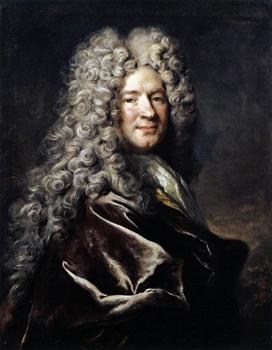
Portrait of a Man in a Purple Robe by Nicolas de Largillière
Just like in the case of heels, the women of today own their wig wearing to the male aristocrats of 17th century Europe. In those times, kings, nobles, composers and other important men could be identified by wearing blond or white curly wigs. These were often adorned with bows or ribbons.
This trend goes back to King Louis XIII of France who was losing his hair and was ridiculed by the English monarch. To place himself above any other king and remain in that position, Louis decided to wear a wig so that he could prove he was the most virile king.
It wasn’t long until this unconventional style became a fashion statement around the royal court, as most of the king’s men started wearing wigs, regardless of whether they were bald or not. It is important to understand that in those times, whatever a monarch did or said was something that was undisputed and it was a crime not to approve of the king.
And, since France was the style epicenter of Europe, the wig trend took off across the rest of Europe like wildfire. Soon enough, the aristocrats were trying to outdo one another and the wigs got bigger and bolder. The result of this trend was the appearance of a whole industry of wig makers, who founded their guild in 1665. It was not long before these wigs were such a strong part of the European culture that you had to wear one if you wanted to climb up in society.
By the late 1700s, men used to pour starch-based powder over their wigs so they would be as white as possible.
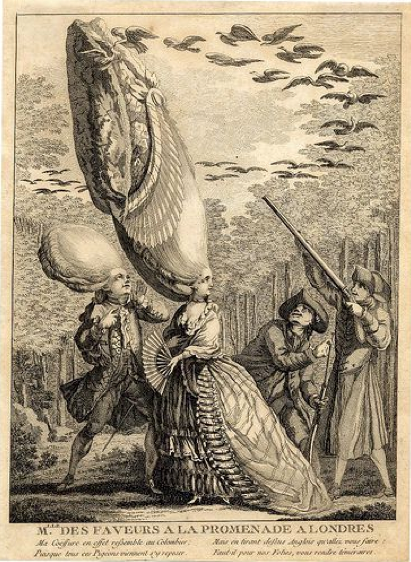
Both men and women were wearing big wigs to show their social status. Here is a very funny and exaggerated representation of the extremes to which people were taking their wigs
The trend ended in England when the government, in an attempt to make money, placed a tax on hair powder. However, this was not the only thing that lead to the disappearance of the wig: the French revolution had brought many social and cultural changes to the world and it was not a positive thing anymore to be seen wearing a sign of the aristocracy.
This trend is actually one of the most long-standing fashion phenomena in European history and we owe it to a balding king.
Chopines
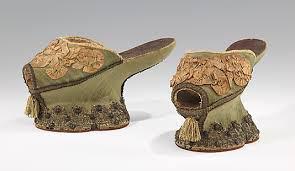
Italian chopines
If you thought the platform shoe appeared in the 1960s, think again! During the Renaissance, Venetian women, especially courtesans wore a type of shoe called the “chopine”. These served as an overshoe that protected a lady’s real shoes and dress from dust and mud, which were very frequent on streets of Italy during the 1500s.
Chopines were made mostly from cork or wood and were covered with velvet or brocade. And, just like in the case of huge wigs, these shoes became a status symbol, ranking the woman who wore the highest heel on highest position in society. According to historical sources, some heels were over 20 inches / 51 cm high.
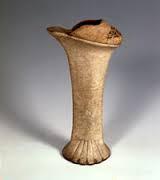
A very tall chopine
Obviously, not every woman can walk on such high platforms, so the chopine-wearing crowd used to be accompanied by a servant on whom they could lean. However, Fabritio Caroso, an Italian dancing master, wrote that a proper lady should be able to dance carelessly regardless of the shoes she is wearing. It was a requirement in those days to be able to dance in chopines if you wanted to call yourself a real courtesan.
Even though these shoes were stylish during the 1500s in Italy, they became fashionable in other parts of Europe as well.
It looks like the Italians have always been one step ahead when it comes to fashion.
Roman unibrows
Apparently, unibrows were so desirable that the Romans had developed cosmetics that would help women filling the space between her eyebrows, should she not have a natural unibrow.
Fake eyebrows
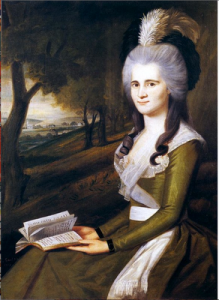
A 1780 portrait of Ester Boardman, who was a lady who wore mouse eyebrows
Speaking of eyebrows, let’s take a look at another way in which women used to make their eyebrows pop back in the day. This time, we are looking at European women from the 18th century, who used to wear false eyebrows. These were made from mouse skin and were made most likely to contrast with the very pale skin which was in style at the time. For those who did not have access to mouse skin, the alternative to dark eyebrows was using black-lead to paint on a well-defined brow.
Lady Mary Wortley Montagu wrote in a 1716 description of the women who went at the theatre that: “All the ladies have…snowy foreheads and bosoms, jet eye-brows and scarlet lips.”
Mouse pelt eyebrows were so embedded in the culture of the time, that there were even poems about them, such as this one:
On little things, as sages write,
Depends our human joy or sorrow,
If we don’t catch a mouse tonight,
Alas! No eyebrows for tomorrow.
The downside, and what probably led to the death of this trend was that these glued eyebrows used to fall easily and you can only imagine how a embarrassing it must have been for a lady if she entered the theatre with two mouse brows and came out with only one.
And, besides worrying that their brows might fall off, women also needed to be careful with the cats around the house, as poet Matthew Prior wrote in a funny 1718 poem:
Helen was just slip into bed
Her eyebrows on the toilet lay
Away the kitten with them fled
As fees belonging to her prey.
No eyebrows
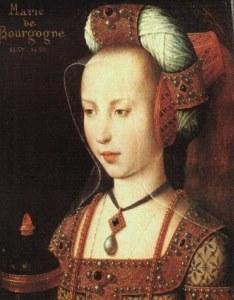
Portrait of Mary of Burgundy (1457 – 1482)
At one point in time, more precisely during the 15th century, it was trendy for women to shave their eyebrows off completely. But the plucking didn’t stop there. Aristocratic women from that era used to also pluck back their hair to obtain a more pronounced forehead.
Patches
Patches were initially used by Romans, who wanted to emulate the goddess Venus who was said to have a beauty mark. However, wearing patches as a fashion statement was something that came into being in the 16th century in England and lasted until the 19th.
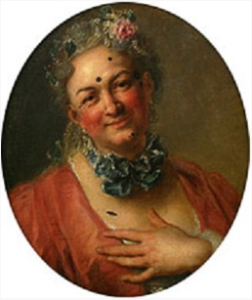 Most people today are not familiar with what patches were and it definitely seems something strange to understand. Basically patches were small pieces of velvet, black silk or fine leather that were glued onto specific parts of the face to highlight certain features or to resemble a beauty mark. For example, one could wear a patch by the corner of the mouth, the corner of the eye or around the temples. At one point, the place where you would glue your patch was an indicator of a message: for example, a patch glued above the lip meant that you were flirty, a patched placed near the eye meant that you were provocative and a patch sticked on a wrinkle was an indicator of a cheerful personality.
Most people today are not familiar with what patches were and it definitely seems something strange to understand. Basically patches were small pieces of velvet, black silk or fine leather that were glued onto specific parts of the face to highlight certain features or to resemble a beauty mark. For example, one could wear a patch by the corner of the mouth, the corner of the eye or around the temples. At one point, the place where you would glue your patch was an indicator of a message: for example, a patch glued above the lip meant that you were flirty, a patched placed near the eye meant that you were provocative and a patch sticked on a wrinkle was an indicator of a cheerful personality.
Patches were also used to cover scars and pimples.
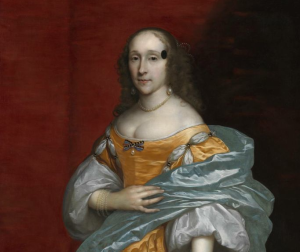 Of course, there were a lot of people who used to exaggerate and wear too many patches, which resulted in them looking like they were covered with flies. In fact, in France and England, patches were called “mouches”, which is the French word for flies, and in Russia they were called “mushka”.
Of course, there were a lot of people who used to exaggerate and wear too many patches, which resulted in them looking like they were covered with flies. In fact, in France and England, patches were called “mouches”, which is the French word for flies, and in Russia they were called “mushka”.
This fashion trend (and addiction for some), was also used to denote political views. According to a 1711 issue of “The Spectator”, “Politically minded dames used their patches as party symbols: the Whigs patching on the right, and the Tories on the left side of their faces, while those who were neutral, decorated both cheeks.”
During the 19th century, both men and women used to wear patches, which could now be found in many shapes, such as square, heart, star, moon, and even as a coach and horses.
This trend lasted until the 1850s, when, after centuries of being in style it wore out and was put aside.
Seen through our eyes, these trends might sound weird and truly awkward. But once you look at the trends we follow today, you can actually conclude that the trends from the past were not very weird. Or were they?
Stay tuned for part II!
Fraquoh and Franchomme
P.S. What do you think of these trends? Would you want any of them making a come-back? Which of today’s trends do you find bizarre? Share your thoughts in the comments below! For more articles on style, fashion tips and cultural insights, you can subscribe to Attire Club via e-mail or follow us on Facebook or Twitter!
Share on Tumblr0
